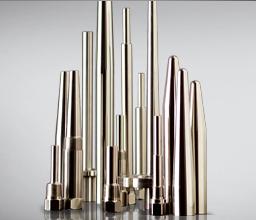We will soon be updating our website with specification data for the many types of thermowells we supply.

Thermowells
- Standard-Duty Threaded Thermowells
- Heavy-uty Threaded Thermowells
- Straight-Shank Threaded Thermowells
- Limited Space Thermowells
- Straight-Shank, Socket Weld Thermowells
- Heavy-Duty, Socket Weld
- Reduced-Tip, Socket Weld
- Weld-In
- Sanitary Weld-In Thermowells
- Standard Flanged Thermowells
- Heavy-Duty, Flanged Thermowells
- Reduced-Tip, Flanged Thermowells
- Heavy-Duty Van Stone
- Straight Van Stone
- Reduced-Tip Van Stone
- Sanitary Connected
- W81 Series Sanitary Weld-In
Here is some general information on thermowell technology.
Thermowells are tubular fittings used to protect temperature sensors installed in industrial processes. A thermowell consists of a tube closed at one end and mounted in the process stream. A temperature sensor such as a thermometer, thermocouple or resistance temperature detector is inserted in the open end of the tube, which is usually in the open air outside the process piping or vessel and any thermal insulation. The process fluid transfers heat to the thermowell wall, which in turn transfer heat to the sensor. Since more mass is present, the sensor’s response to process temperature changes is delayed. If the sensor fails, it can be easily replaced without draining the vessel or piping. To be representative of the average temperature of fluid, the thermowell must extend a few per cent of the inside diameter of the process pipe or vessel.
A thermowell is typically machined from solid bar stock and gun-drilled to ensure a long straight bore that closely approximates the diameter of the installed sensor (ex: a .260″ bore matching a .250″ sensor). A thermowell is typically mounted into the process stream by way of a threaded, welded, sanitary cap or flanged process connection. The temperature sensor such as a thermometer, thermocouple or resistance temperature detector is inserted in the open end of the thermowell and typically spring loaded to ensure that the outside tip of the temperature sensor is in metal to metal contact with the inside tip of the thermowell.
Thermodynamically, the process fluid transfers heat to the thermowell wall, which in turn transfer heat to the sensor. Since more mass is present with a sensor-well assembly than with a probe directly immersed into the process, the sensor’s response to process temperature change is slowed by the addition of the well. Since the mass of the thermowell must be heated to the process temperature, and since the walls of the thermowell conduct heat out of the process, sensor accuracy and responsiveness is negatively impacted by the addition of a thermowell.
To be representative of the average temperature of fluid, the thermowell must extend a few percent of the inside diameter of the process pipe or vessel. [1] A rule of thumb that is sufficient for most industrial applications (apx. 1% accuracy) is to ensure that the thermowell projects 5 times its own diameter into the process plus the length of its sensing element. So, for a grounded thermocouple spring loaded into a thermowell with a 1 inch diameter shank and a tip thickness of .25″ a typical immersion length would equal 5.5 inches (1″ OD x 5 + .25″ well tip thickness +.25″ sensor wall thickness = 5.5″).
Our purpose is to correctly identify needed items and have them delivered on time at maximum value. We routinely handle this by direct contact with our customers, maintenance operations, production, engineering and/or purchasing. If in doubt as to our scope of supply, please contact us via our online form or call us at (800) 446-4316.
